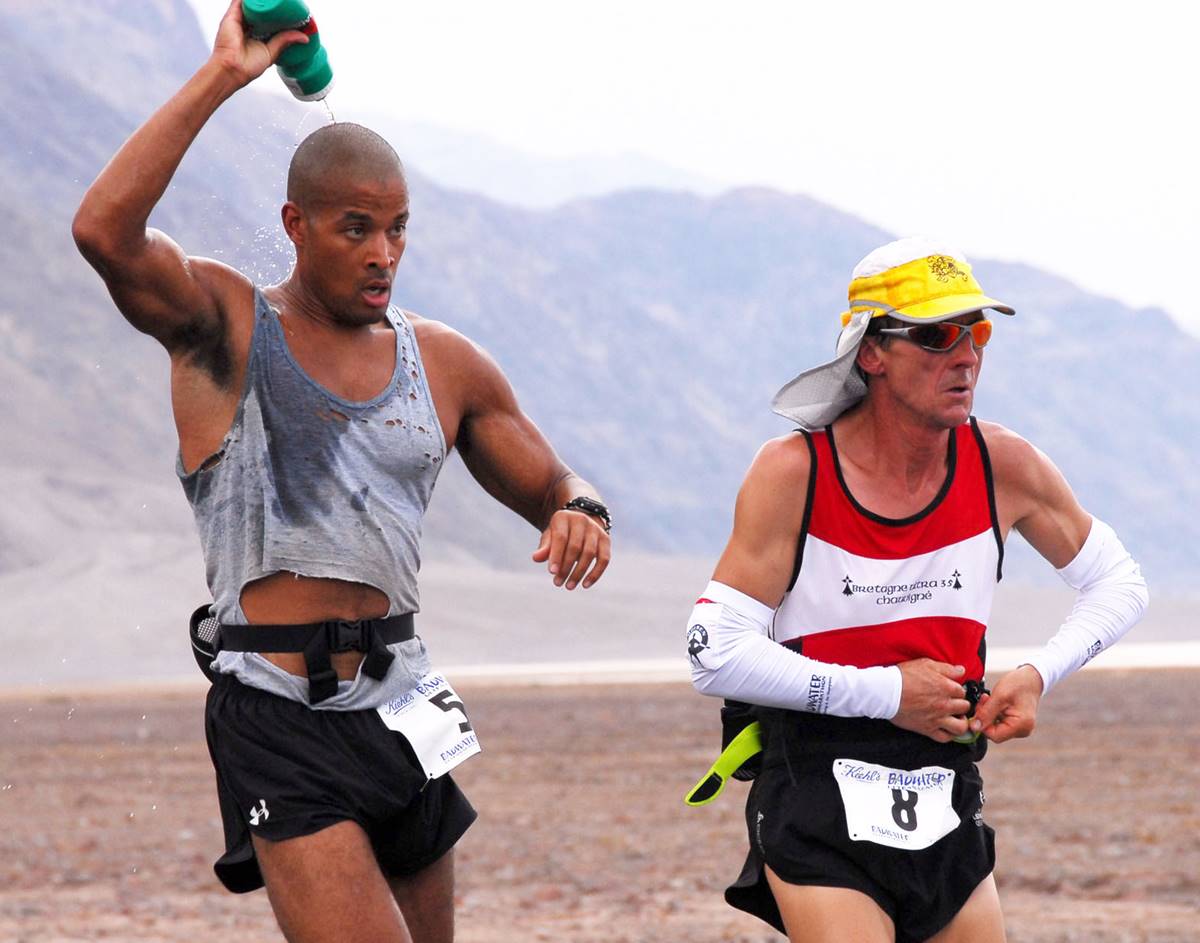Home>Misc>Featured>What Happens To Your Body During An Ultramarathon


Featured
What Happens To Your Body During An Ultramarathon
Modified: January 2, 2024
Discover what happens to your body during an ultramarathon and how to train for this challenging feat. Featured in-depth insights and expert advice for endurance athletes.
Introduction
Welcome to the world of ultramarathons, where ordinary runners take on the extraordinary challenge of running distances that exceed the traditional marathon length of 26.2 miles. An ultramarathon can span from 50 kilometers (31 miles) to as long as 100 miles or more, pushing the human body and mind to their limits.
Participating in an ultramarathon is not just a physical feat; it is a mental and emotional journey as well. Runners must train rigorously, build endurance, and develop mental fortitude to endure hours upon hours of non-stop running. The experience is grueling, yet incredibly rewarding.
In this article, we will take a deep dive into what happens to your body during an ultramarathon, starting from the training and preparation phase all the way to crossing the finish line and the post-race effects.
Before we delve into the details, it’s important to note that ultramarathons are not for the faint of heart. They require a high level of commitment, discipline, and perseverance. Proper training and preparation are essential to prevent injuries and ensure a successful race.
Training and Preparation
Preparing for an ultramarathon requires a well-thought-out training plan that gradually increases mileage and builds endurance. Most training plans span several months, allowing the body to adapt and prepare for the physical demands of running long distances.
During training, runners focus on increasing their weekly mileage, incorporating back-to-back long runs, and including cross-training activities to strengthen their overall fitness. They also pay close attention to nutrition, ensuring they consume adequate calories, carbohydrates, and protein to support their training and recovery.
In addition to physical training, mental preparation is crucial in an ultramarathon. Developing a strong mindset to overcome fatigue, doubt, and challenges encountered during the race is essential. Runners often practice visualization techniques, mental rehearsal, and positive self-talk to build mental resilience.
It’s important to note that every individual is different, and what works for one person may not work for another. Tailoring the training plan and preparation to individual needs and abilities is key to success in an ultramarathon.
As the race day approaches, runners often participate in shorter-distance races or tune-up races to fine-tune their pacing strategies, practice fueling and hydration techniques, and gain valuable race-day experience.
Proper gear selection is also crucial in ultramarathons. Choosing the right shoes, socks, clothing, and accessories that provide comfort, support, and protection against the elements can make a significant difference in the overall performance and enjoyment of the race.
Overall, the training and preparation phase sets the foundation for a successful ultramarathon. It builds the physical and mental strength necessary to endure the challenges of the race and ensures that runners are adequately prepared for the demands they will face on race day.
The Start Line
Standing at the start line of an ultramarathon is a mix of excitement, anticipation, and nerves. The air is filled with the energy of hundreds or even thousands of runners ready to embark on their epic journey.
The race begins with a surge of adrenaline as runners take off, eager to find their rhythm and settle into their pace. The start of an ultramarathon is often crowded, with runners jostling for position and finding their space within the pack.
Maintaining a steady pace and avoiding the temptation to start too fast is crucial in the early stages of the race. Runners need to conserve their energy and find a pace that they can sustain for the long haul. It’s a delicate balance of pushing oneself without burning out too quickly.
As the initial miles tick by, the excitement starts to fade, and runners settle into the rhythm of their strides. There is usually a sense of camaraderie among the participants, as they share a common goal and understanding of the challenges that lie ahead.
At the start line, it’s important to stay focused, trust in your training, and embrace the journey that lies ahead. The beginning of an ultramarathon sets the tone for the entire race, and the mental approach is just as crucial as the physical aspect.
Some runners prefer to start steady and gradually increase their pace, while others may choose to go out strong and settle into a steady rhythm later on. Finding a strategy that works best for individual preferences and abilities is key to a successful start.
While the start line is full of excitement and adrenaline, runners must also be mindful of pacing and fueling strategies from the get-go. Ensuring proper hydration and nutrition early on can help prevent depletion and maintain energy levels throughout the race.
Regardless of how experienced or prepared you may feel at the start line, remember that an ultramarathon is a long-distance battle that requires patience, perseverance, and resilience. The start line is just the beginning of a challenging, yet immensely rewarding, journey.
Mile 0-10: The Early Stages
The first 10 miles of an ultramarathon are often characterized by a mix of excitement, adrenaline, and finding your rhythm. As the race unfolds, runners settle into their pace, gradually finding their stride and getting comfortable with the long-distance journey that lies ahead.
During this phase, it’s important to focus on maintaining a steady and sustainable pace. It’s easy to get caught up in the energy of other runners and push harder than necessary in the early stages, but pacing is key to conserving energy for the later miles.
Many ultramarathons are held in scenic locations, and the early miles often take runners through breathtaking landscapes. Enjoying the surroundings and taking in the beauty of nature can help distract from any initial fatigue and provide a sense of motivation and inspiration.
Hydration and fueling strategies come into play from the very beginning. Properly hydrating and fueling the body throughout the race is crucial for maintaining energy levels and preventing dehydration and fatigue. It’s important to follow the nutrition plan practiced during training and adjust as necessary based on race-day conditions.
During the early stages, runners may encounter minor physical discomforts such as muscle stiffness, tightness, or aches. This is normal as the body adjusts to the demands of the race. It’s important to listen to your body, make necessary adjustments in form or pace, and address any discomfort early on to prevent it from escalating into more significant issues.
Mentally, the early stages can be a mix of excitement and anticipation, as well as some doubts creeping in. It’s important to stay focused and positive, reminding yourself of the training and preparation you have put into this moment. Breaking the race into smaller segments and focusing on one milestone at a time can help maintain motivation and alleviate any overwhelming thoughts.
Support from fellow runners and race volunteers can be invaluable during the early stages. Encouragement from those around you can provide a boost to spirits and help keep motivation high. Additionally, establishing a rhythm and pacing with a running buddy or a group can provide a sense of community and support.
Mile 0-10 sets the tone for the rest of the race. It’s a time of finding your groove, adjusting to the demands of the race, and mentally preparing for the challenges ahead.
Mile 10-20: Finding Your Rhythm
As runners push through the first 10 miles of the ultramarathon, a sense of familiarity and rhythm begins to emerge. During this phase, runners settle into their pace, both physically and mentally, and start to find their groove.
The early excitement and adrenaline of the race start have now settled, and runners have established a comfortable stride. The body begins to adapt to the demands of the race, and muscles start to loosen up as they warm up.
At this stage, it’s crucial to listen to your body and make any necessary adjustments to form or pace. This can help prevent overexertion and ensure a sustainable pace throughout the race. It’s also a good time to check in with your hydration and fueling plan to ensure that you’re adequately nourishing your body.
Runners often find solace in the second 10-mile segment as they enter a mental state of focus. The early doubts have given way to a sense of confidence, knowing that they have successfully overcome the first leg of the race. This mental shift can be a powerful motivator as they continue along the course.
During this phase, camaraderie among runners grows stronger. Bonds are formed as runners share similar experiences and push each other to keep going. Encouragement from fellow participants and spectators offers a boost of motivation and reminds runners that they are part of a supportive community.
The physical toll on the body becomes more apparent during mile 10-20. Muscles can start to feel fatigued, and runners may experience aches or tightness. It’s important to stay focused and maintain good running form to minimize the risk of injury. Stretching and proper recovery techniques during aid station breaks can help alleviate some of the discomfort.
Managing mental fatigue becomes increasingly important in this stage. Distractions, such as engaging in positive self-talk, visualizing the finish line, or focusing on the next milestone, can help keep the mind engaged and motivated. Mentally breaking the segment into smaller, manageable parts can provide a sense of progress and make the distance feel more attainable.
As runners approach the 20-mile mark, they have surpassed the halfway point of the race. This milestone offers a renewed sense of motivation and reminds them of the progress they have made. It’s a moment to reflect on their physical and mental strength and to prepare for the challenges that lie ahead in the latter half of the ultramarathon.
Mile 20-30: Pushing Through the Midpoint
As runners enter the 20-30 mile range of an ultramarathon, they reach the midpoint of the race. This segment can be both physically and mentally demanding, pushing runners to their limits.
During this phase, fatigue starts to set in, and the body may begin to feel the cumulative effects of the distance covered so far. Muscles may ache, and energy levels can dip. It’s essential to stay focused on maintaining proper hydration and fueling to sustain energy levels and prevent dehydration or bonking.
Pushing through the midpoint requires mental resilience. Doubts and negative thoughts may arise as fatigue and discomfort intensify. It’s crucial to draw upon mental strategies, such as positive self-talk, visualization, or dedicating each mile to someone or something meaningful, to stay motivated and focused.
At this stage, the support of fellow runners and spectators becomes even more crucial. Encouragement from others can provide a much-needed boost of motivation and remind runners that they are not alone in this challenging endeavor. Aid stations also offer a welcome respite, providing hydration, snacks, and support from volunteers who understand the physical and mental struggles participants face.
Managing pacing during this stretch is vital. Pushing too hard at this point may lead to burnout later on, while holding back too much may result in missed opportunities to gain time and momentum. It’s a delicate balance that each runner must navigate, using their experience and self-awareness to make the best decisions.
Mentally breaking the distance into smaller, manageable chunks can help overcome the daunting nature of the remaining miles. Focusing on reaching the next aid station or completing a certain number of miles before taking a walking break can provide a sense of achievement and make the overall distance feel more attainable.
As the 30-mile mark approaches, runners can take solace in the fact that they have covered a significant portion of the race. This milestone serves as a reminder of their strength and determination. It’s a time to reflect on the progress made and to gather the mental and physical strength needed to tackle the final miles of the ultramarathon.
Mile 30-40: Battling Fatigue and Mental Challenges
As runners progress from mile 30 to 40 in an ultramarathon, the physical and mental challenges become more pronounced. Fatigue creeps in, muscles ache, and doubts may arise. This segment requires a great deal of mental resilience and determination to push through.
Physical fatigue can be pervasive during this phase. Muscles may feel heavy and tired, and the body may begin to show signs of wear and tear. Proper hydration, nutrition, and pacing become even more crucial to sustain energy levels and prevent physical breakdown.
The mental challenges faced in this stage can be significant. Doubts and negative thoughts may creep in, questioning one’s ability to continue. It’s important to acknowledge these thoughts but not dwell on them. Instead, focus on positive self-talk, reminding oneself of the training and preparation that have brought them this far.
Runners often break down the remaining distance into smaller and more manageable intervals, focusing on reaching the next aid station or completing a certain number of miles before taking a short walking break. This mental approach helps maintain motivation and shifts the focus from the overall distance to achievable goals.
Support from fellow runners and spectators becomes increasingly important during this phase. Encouragement from others can provide a tremendous boost of motivation, reminding runners that they are not alone in their struggle. The camaraderie and shared experience among participants can be a powerful source of inspiration and strength.
Maintaining mental focus becomes critical in battling fatigue. Running with purpose, such as dedicating miles or moments to loved ones, can provide a meaningful source of motivation. Visualization techniques, picturing oneself crossing the finish line, can also help push through the mental challenges encountered along the way.
As the body continues to face physical and mental fatigue, runners must also remain vigilant about self-care. Taking advantage of aid stations to stretch, refuel, and address any discomfort is crucial. This can help alleviate physical strain and provide a mental boost as runners prepare for the final push to the finish line.
Reaching the 40-mile mark signifies both endurance and resilience. It marks the closing stages of the race, motivating runners to summon their last reserves of energy and summon their determination to conquer the remaining miles.
Mile 40-50: The Final Stretch
As runners enter the final stretch of an ultramarathon, the emotions are a mix of relief, determination, and exhaustion. Mile 40-50 is the last leg of the race, demanding every ounce of physical and mental strength to reach the finish line.
At this stage, fatigue is at its peak, and muscles may feel heavy and weary. Endurance becomes a vital asset, and runners rely on their training and mental fortitude to keep moving forward. Proper fueling and hydration continue to be crucial for sustaining energy levels and preventing depletion.
The mental challenges in this segment can be intense. Doubts may cast a shadow, with the finish line still seeming distant. It’s essential to remain focused on the ultimate goal and draw strength from the progress made so far. Remind yourself of the training, the sacrifices, and the determination that brought you to this point.
Breaking down the remaining distance into smaller segments and celebrating each milestone achieved can help maintain momentum. Focus on reaching each aid station, passing each mile marker, or simply embracing the joy in each step, no matter how tired you may feel.
The support of fellow runners, spectators, and race volunteers becomes paramount during this final stretch. Their cheers and encouragement provide a surge of motivation and much-needed emotional support. Remember that you are not alone in your struggle. The collective energy and camaraderie of the participants can push you to dig deeper and find that extra inner reserve of strength.
While fatigue may feel overwhelming during mile 40-50, there may also be moments of exhilaration and clarity. As the finish line draws closer, a sense of accomplishment and excitement builds. This can spur runners on and provide a renewed sense of purpose and determination.
Maintaining good running form, even when tired, is crucial to prevent injury and maximize efficiency. Be mindful of your body’s signals and make any necessary adjustments to your running technique or pace. Lean on your training and experience to find the right balance between pushing your limits and ensuring your well-being.
As you approach mile 50, the finish line is within reach. The crowd’s cheers grow louder, motivating you to give your all and leave nothing on the course. Dig deep, embrace the discomfort, and envision the moment of crossing the finish line. You are on the cusp of achieving something truly extraordinary.
Mile 50-60: Testing Your Limits
As runners enter mile 50-60 of an ultramarathon, they are truly testing their limits both physically and mentally. This segment of the race is known for its grueling challenges and relentless demands on the body and mind.
Physically, fatigue becomes more pronounced, and the body may experience a myriad of discomforts. Muscles ache, blisters may have formed, and overall exhaustion sets in. This is the time when runners must truly push beyond their perceived limits and tap into their deepest reserves of strength.
Mental resilience becomes paramount during this phase. Doubts and negative thoughts may intensify as the body endures the ever-increasing strain. Maintaining a strong mindset and focusing on positive self-talk and visualization techniques can help combat mental fatigue and keep motivation high.
The support of fellow runners and race volunteers becomes even more crucial during mile 50-60. Encouragement from others who understand the unique challenges of an ultramarathon can provide a powerful source of motivation. The collective energy and camaraderie among participants help push everyone forward, fostering a shared sense of determination and grit.
Managing hydration and nutrition is essential to sustain energy levels. Runners must continue to fuel their body with the necessary carbohydrates, proteins, and fluids to maintain endurance. Sticking to a well-practiced nutrition plan and adjusting as necessary based on how the body is responding can make a significant difference in performance and overall well-being.
The terrain may become increasingly challenging during this stretch of the race. Uphill climbs, steep descents, or technical trails can test runners’ agility and focus. It’s important to adapt to the conditions, adjust running form as needed, and remain mentally present to navigate these obstacles safely and efficiently.
The mental and physical toll of mile 50-60 can be overwhelming, but this is also where some of the most awe-inspiring moments occur. Runners often uncover a newfound sense of resilience and determination they never knew they possessed. Each step is a testament to their strength and commitment to pushing through adversity.
As they approach the final stretch of the race, runners draw upon every ounce of strength within themselves. The finish line is no longer a distant concept; it’s a tangible goal that motivates them to persist, no matter how physically and mentally challenging the journey may become.
Mile 50-60 is where legends are made, where runners truly test their limits and discover the depths of their capabilities. It’s a true testament to the human spirit’s power, resilience, and unwavering determination to conquer great challenges.
The Finish Line
Crossing the finish line of an ultramarathon is an indescribable moment of triumph, a culmination of months of preparation, physical endurance, and unwavering determination. As runners approach the final moments of their race, a powerful mix of emotions takes over.
The sight of the finish line, often marked by a vibrant arch and cheering spectators, provides an incredible surge of motivation. The crowd’s energy fuels the runners, pushing them towards the culmination of their journey and the achievement of their goal.
Physically, the body is both exhausted and exhilarated. Muscles ache, joints may be stiff, and the accumulated fatigue is at its peak. Yet, adrenaline takes over, and runners draw their final reserves of energy to propel themselves forward.
As the finish line nears, a wave of emotions washes over runners. Exhaustion mixes with elation, a sense of relief blends with an overwhelming sense of pride. Tears may flow as the monumental feat of completing an ultramarathon becomes a reality.
Crossing the finish line is not just a personal victory; it is also a celebration of the entire journey. Runners reflect on the months of training, the sacrifices made, and the hurdles overcome. They embrace the incredible sense of accomplishment that comes with pushing their limits and defying what they once believed was possible.
The finish line is a place of unity, where all participants come together in their shared pursuit of endurance and determination. Runners congratulate each other, exchanging smiles, high-fives, and words of congratulations. The sense of camaraderie and respect among ultramarathoners is truly incredible.
Reaching the finish line also marks the epitome of personal growth and resilience. The mental strength required to overcome doubt, fatigue, and physical discomfort is immeasurable. It is a transformative experience that shapes runners into stronger, more resilient individuals.
As runners cross the finish line, the realization dawns that they are part of a select few who have accomplished such an extraordinary feat. The memories and lessons learned during the race will stay with them forever, serving as a constant reminder of their incredible capabilities.
The finish line is not just an end; it is a new beginning. It symbolizes the fulfillment of a dream and the birth of new aspirations. Runners leave the race with a renewed sense of purpose, eager to tackle new challenges and continue their journey of growth and self-discovery.
Crossing the finish line of an ultramarathon is an unforgettable moment of triumph, marking the culmination of physical and mental endurance. It is a testament to the human spirit’s ability to strive, overcome, and push beyond limits. It is a celebration of resilience, strength, and the unbreakable determination to achieve the extraordinary.
Recovery and Post-Race Effects
After crossing the finish line of an ultramarathon, the focus shifts from the immediate sense of accomplishment to the essential process of recovery. The body and mind require time and care to heal and rejuvenate following the intense physical and mental demands of the race.
Recovery begins with rest and replenishment. Sleep is crucial for the body to repair itself and regain energy. Proper nutrition, incorporating a balance of carbohydrates, proteins, and healthy fats, helps replenish depleted glycogen stores and support muscle repair. Hydration is also essential, as the body needs to rehydrate after hours of exertion.
Physical recovery can take weeks or even months, depending on the individual and the intensity of the race. Giving the body ample time to rest and gradually reintroducing physical activity is key to preventing post-race injuries and ensuring a complete recovery.
During the recovery period, active recovery techniques such as low-impact exercises, light stretching, and foam rolling can help reduce muscle soreness and aid in the restoration of mobility and flexibility. Massage therapy and other forms of bodywork can also assist in alleviating tension and promoting healing.
Post-race, runners may experience a range of emotions. There can be a sense of post-race blues or a void that comes from the absence of the intense training and race day routine. It’s important to acknowledge and honor these emotions, allowing oneself time to reflect on the accomplishment and adjust to the shift in focus and routine.
The post-race period also provides an opportunity for self-reflection and growth. Runners can evaluate their performance, analyze areas for improvement, and set new goals for future races. The experience of the ultramarathon becomes a foundation for personal growth, resilience, and increased self-belief.
Celebrating the accomplishment is an integral part of the post-race phase. Sharing the experience with loved ones and fellow runners, sharing stories, and relishing in the shared joy can be incredibly gratifying. This celebration serves as a reminder of the community that surrounds and supports the pursuit of endurance challenges.
Post-race effects can vary from person to person and depend on various factors such as race intensity, training background, and individual recovery practices. Some runners experience an immediate desire to sign up for their next challenge, while others may need more time to regroup and reassess their future goals.
Ultimately, the recovery and post-race period is a time of renewal, self-reflection, and self-care. It offers an opportunity to celebrate the accomplishment, heal the body and mind, and plot a course for future endeavors. The experience gained from completing an ultramarathon leaves an indelible mark, serving as a reminder of the incredible capabilities that lie within each individual.
Conclusion
Participating in an ultramarathon is a profoundly challenging and transformative experience that pushes the limits of both the body and mind. From the training and preparation phase to crossing the finish line and the post-race recovery process, every step of the journey presents unique challenges and opportunities for growth.
Throughout the race, runners must navigate physical fatigue, mental hurdles, and the unpredictable terrain. They find solace in the camaraderie of fellow runners, draw upon mental resilience, and tap into their deepest reserves of physical strength to push forward.
The journey teaches runners not only about their own capabilities but also about the power of persistence, dedication, and the unwavering determination to overcome obstacles. Ultramarathons are a true test of endurance, grit, and the relentless pursuit of personal growth.
Crossing the finish line of an ultramarathon signifies an incredible personal victory and inherently inspires a sense of awe and respect. It is an achievement that extends far beyond the race itself, reaching into the depths of one’s character and fortitude.
The post-race recovery phase provides an opportunity to reflect, rest, and set new goals. It allows runners to celebrate their accomplishment and harness the lessons learned from the ultramarathon experience to fuel future endeavors.
Ultramarathons, though physically and mentally demanding, hold incredible rewards for those who embrace the challenge. They bring out the best in runners, pushing them to go beyond their perceived limits and discover the extraordinary within themselves.
Whether it’s the scenic trails, the sense of community among participants, or the personal growth that comes with conquering such a feat, an ultramarathon is an adventure that will forever be etched in the memories of those who dare to take on this extraordinary pursuit.
So lace up your shoes, train hard, and embrace the incredible journey that awaits. The world of ultramarathons beckons, ready to test your limits and reveal the untapped wells of strength and determination within you. Are you ready to embark on this incredible adventure?









